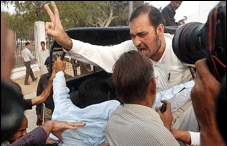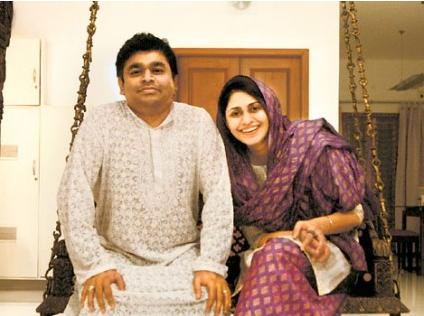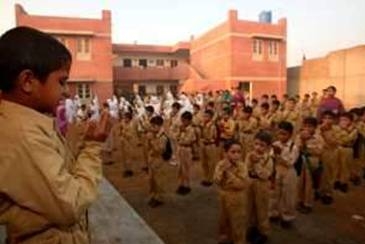By Pippa Virdee
The article was published on open Democracy.
The emancipation of women is often linked to the progress of a society in transformation from a feudal society to a modern state. The story of women in the country that became Pakistan can indeed be told in such terms: as part of a struggle for advancement with education at its centre, and linked at critical moments to wider goals of national emancipation and social reform.
During the past thirty years, however, the quest for women’s rights in the context of such reform has been under increasing pressure from a trend toward state-sponsored Islamisation. This trend, which began under the authoritarian rule of Zia ul-Haq (who seized power in a military coup in 1977), is symbolised by the punitive flogging of a young woman in the newly Talibanised region of Swat. The fighting ground, it appears, is always women’s space.
Pippa Virdee is senior research fellow in south Asian history at De Montfort University. Her research interests include the history of the Punjab, Muslim women’s experience of partition, and the south Asian diaspora in Britain. She is the convenor of the Punjab Research Group
A pioneering moment
Syed Ahmad Khan (1817-98) – an educator and reformist politician – was at the forefront of advocating modern education for Muslims, including women. He promoted liberal interpretations and challenged traditional views on the institutions of purdah (literally “veil”) and polygamy. Although girls were gradually receiving an education under the British colonial power, most Muslim women remained largely untouched by these campaigns; it was only in 1895 that one of the first Muslim girls’ schools was founded (by Amina Tyabji), followed in 1906 by a girls’ school at Aligarh (opened by Nawab Sultan Jahan, who as begum of Bhopal was one of the few female rulers of a princely state in India).
The Aligarh girls’ school was the wellspring of the All-India Muslim Ladies’ Conference, established in 1914. Its prominent sponsors included Sultan Jahan and Shaikh Abdullah and his wife, Waheed Jahan Begum. The conference failed to achieve recognition and folded in 1931; yet such organisations played a crucial role in forging the connection between ameliorative social reform, women’s education, and nationalist policies.
When Mohammad Ali Jinnah (1876-1948) assumed the helm of the Muslim League he envisaged the participation of women as important in advancing the goals of the party; thus he sought to push the boundaries of women’s emancipation. Jinnah was studying in London when the suffragettes were demanding the right to vote and he was genuinely interested and supportive of women’s rights.
This was reflected in his speech at the Islamia College for Women on 25 March 1940, when he asserted:
“I have always maintained that no nation can ever be worthy of its existence that cannot take its women along with the men. No struggle can ever succeed without women participating side by side with men. There are two powers in the world; one is the sword and the other is the pen. There is a great competition and rivalry between the two. There is a third power stronger than both, that of the women.”
Almost exactly four years later, at a meeting of the Muslim University Union in Aligarh on 10 March 1944, he went further:
“We are victims of evil customs. It is a crime against humanity that our women are shut up within the four walls of the houses as prisoners. There is no sanction anywhere for the deplorable condition in which our women have to live.”
In part the latter declaration reflected a genuine desire by Jinnah to see women shed their veils and venture beyond the “four walls”; but he was also aware that realising the political ambitions of the Muslim League required mass participation (including by women). Muslim women until then had on the whole been in a condition of purdah which meant they were secluded from public life – yet here was a call for them to shed that and join the political struggle.
At the forefront of this movement were elite women such as Jinnah’s sister, Fatima Jinnah (1893-1967); Begum Ra’ana Liaquat Ali Khan (1905-90), the wife of Pakistan’s first prime minister; Begum Shah Nawaz (1896-1979); Shaista Ikramullah (1915-2000), who struggled for the opportunity to get an education and went on to do a PhD at the University of London; and Abida Sultan (1913-2002), who was an ardent supporter of the Muslim League and belonged to Bhopal’s royal family. These figures served as early role-models for other women to “come out”.
A generation’s dreams
In 2008, I was fortunate enough to meet one of the few women still alive and able to recount the fervent days of Muslim League’s demand for a separate state. Fatima Sughra as a 14-year-old in 1947 was inspired by the message of the Muslim League and she convinced her father that she wanted to be involved in the movement along with the other women. She recalled that at a huge gathering in Lahore, hundreds of women had gathered around the Punjab secretariat building:
“I along with my friends reached the assembly hall that day. I saw at that time a big crowd was shouting and chanting slogans: “Zindabad (long live) the Muslim League; Zindabad Quaid-i-Azam; ban kay rayga Pakistan (Pakistan will be created) …I think it was in February or March 1947…I remember the day I removed the Union Jack and replaced it with a Muslim League flag. Many Muslim women [who had never stepped out from their house before] came out from their houses and took over the streets of the city. This was all happening because the begums [the elite Muslim League Women leadership] went door-to-door and convinced the Muslim women to come out from their homes for the protests. I don’t know what sort of passion was inside me at time, I just jumped over the secretariat gate…”
Fatima Sughra was awarded a gold medal for her services to Pakistan, whose nationalist movement she has come to symbolise; the image of her hoisting the Muslim League flag are replayed every year during the independence-day celebrations. The inspiration is real: for after the creation of Pakistan, women did continue to extend the boundaries of their rights and were increasingly visible in public life.
Yet the dreams of this generation have hardly been fulfilled. In the post-1979 period especially – a watershed in the wider Islamic world as well as Pakistan – there was a dramatic change in attitudes towards women. Zia-ul-Haq (1924-88) after his coup d’état in 1977 pursued a policy of Islamisation that gathered pace throughout the 1980s.
The impact on women was particularly felt around the hudood ordinances which made it very difficult to distinguish between adultery (zina) and rape (zina-bil-jabr), and impossible for women to prove rape. This process undermined the position of women and created a climate of intimidation; even under the governments headed by Benazir Bhutto the ordinances remained in place (they were repealed only in 2006).
An unfulfilled promise
More recently, the influence of Islamist parties has in Pakistan grown further, with conservative elements often protesting against women as “soft targets”. In 2006, women were targeted on account of their participation in mixed-sex marathons in Gujranwala and Lahore; and “honour killings” have become a regular occurrence. But the real question is about how women reconcile their position in contemporary Pakistan.
Gulnar Tabassum, who works for Shirkat Gah (a private NGO based in Lahore) conveys a sense both of optimism and concern for the future. She describes with pride how, when Pervez Musharraf suspended the chief justice of the supreme court, Iftikhar Mohammed Chaudhry in 2007, the Women’s Action Forum (WAF) was the first group to show solidarity with the incipient lawyers’ movement.
But Gulnar also reflects on the changes in women’s status in Pakistan which started during the Zia ul-Haq regime, and which have be to seen through the prism of wider political developments. She highlights too the significant changes in Punjabi society, historically a quite open and free rural society yet now exposed to extremist religious influences. Even in the more cosmopolitan urban areas, the same trend is apparent.
Gulnar Tabassum recalls an incident in Lahore’s chic middle-class shopping district Liberty Market, where an old man used a microphone vainly to harangue passing women to cover themselves. It is in fact more common nowadays to see women (even in the big cities) wearing a headscarf, yet the reasons for this vary and cannot be reduced to a straightforward act of faith; an expression of identity, a fashion statement, a reaction against the “western” ideal are some of the considerations that may underlie the choice.
There has always been a clear difference between urban and rural areas, with educated women in the former being afforded greater opportunities. By contrast, women in rural areas often lack the education, the confidence,and the knowledge to challenge authority. Public institutions such as police-stations and courts are dominated by men; they inhibit women, especially if alone, from entering such male-dominated spaces.
When Fatima Sughra vaulted the secretariat building to hoist the flag of the Muslim League in 1947, she carved for herself a revered place in Pakistan’s history. The doors that were opened in that period for women to enter public space and social life are now for many of their daughters and granddaughters being threatened with closure. If women are truly to move beyond the confines of the “four walls” and make their contribution to the future of Pakistan, it is education – and the sense of belonging to and ownership of the country that it brings – that will enable them to do it.




Recent Comments